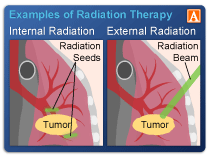
Diagnosed with Cancer? Your two greatest challenges are understanding cancer and understanding possible side effects from chemo and radiation. Knowledge is Power!
Learn about conventional, complementary, and integrative therapies.
Dealing with treatment side effects? Learn about evidence-based therapies to alleviate your symptoms.
Click the orange button to the right to learn more.
- You are here:
- Home »
- Blog »
- side effects ID and prevention »
- Radiation-induced Nerve Damage
Radiation-induced Nerve Damage

I believe that radiation-induced nerve damage occurs more often than oncology has reported. I say this because radiation-induced nerve damage, of any kind, is a late stage side effect. As such, the cancer survivor may not experience real problems for years after their radiation therapy.
Years after radiation therapy, the patient may experience a cancer relapse, may be struggling with other health issues or may even already have died of their original cancer.
If I didn’t know better, I would say that the research linked and excerpted below is reporting my radiation-induced lumbosacral plexopathy (RILP). Why? Because of comments such as:
- “It was diagnosed that the patient developed RIBP due to a combination of factors, including surgery and chemotherapy, in addition to radiation exposure…”
- ” Neurological symptoms typically emerge between two to four years post-radiation [1] and as early as 1.5 months [10] to several years (up to 20 years) after irradiation [11], correlating with the administered radiation dose…”
I too underwent surgery, chemotherapy as well as radiation therapy. I too developed neurological symptoms between two and four years post-radiation (1998,1999, 2000) and continue to slowly loose muscle strength to this day (2024).
How many types of radiation-induced nerve damage are there?
Radiation-induced nerve damage, also known as radiation neuropathy, can manifest in various forms. The specific types and severity of damage depend on factors such as the type of radiation, dosage, and the area of the body exposed. Some common types of radiation-induced nerve damage include:
- Acute Radiation Syndrome (ARS): This occurs shortly after exposure to high doses of radiation and can affect the nervous system, leading to symptoms like nausea, vomiting, confusion, and seizures.
- Chronic Radiation Neuropathy: Long-term exposure to lower doses of radiation can cause chronic nerve damage. Symptoms may include numbness, tingling, weakness, and pain in the affected areas.
- Peripheral Neuropathy: Radiation can damage the peripheral nerves, leading to symptoms such as numbness, tingling, and weakness in the extremities.
- Radiation-induced Lumbo-sacral Plexopathy (RILP)- radiation to the iliac crest or pelvic area can cause numbness and weakness to the lower body.
- Cranial Neuropathy: Radiation can affect the nerves in the head, leading to symptoms like facial numbness, difficulty swallowing, or changes in vision or hearing.
- Brachial Plexopathy: Radiation to the chest or neck region can damage the brachial plexus, a network of nerves that control the muscles of the shoulder, arm, and hand. This can result in weakness, pain, and numbness in the affected arm.
What therapies can reduce the risk of radiation damage?
- Antioxidants: Antioxidants, such as vitamins C and E, may help protect cells from damage caused by free radicals generated during radiation exposure.
- Amifostine (Ethyol): This is a drug that may help protect normal cells from the effects of radiation during cancer treatment.
- Hyperbaric Oxygen Therapy (HBOT): Some studies suggest that HBOT may help reduce radiation-induced damage by increasing oxygen levels in tissues.
- Topical Agents: Depending on the type of radiation exposure, topical agents like aloe vera or specialized creams may be used to soothe and heal the skin.
- Healthy Diet: Eating a balanced and nutritious diet can support overall health, potentially aiding in recovery from radiation damage.
- Radioprotective Drugs: Some drugs are being investigated for their potential to protect against radiation damage. These may include compounds like radioprotectors or mitigators.
- Acupuncture- some studies cite acupuncture as a therapy to increase blood flow to minimize nerve pain.
Have you undergone radiation? Do you think radiation has caused damage to your nerves? How? Let me know-
David.PeopleBeatingCancer@me.com
David Emerson
- Cancer Survivor
- Cancer Coach
- Director PeopleBeatingCancer
“Brachial plexopathy is a form of peripheral neuropathy. It occurs when there is damage to the brachial plexus. This is a group of nerves that run from the lower neck through the upper shoulder area.”
A Case of Radiation-Induced Brachial Plexopathy Below the Tolerance Dose
“This case report details a rare instance of radiation-induced brachial plexopathy (RIBP) occurring below the typical tolerance dose in a 55-year-old woman following chemoradiotherapy for apical non-small cell lung carcinoma. Despite receiving a radiation dose considered safe (47-48 Gray in 25 fractions), she developed sensory abnormalities and motor weakness in the right upper limb…
The case underscores the importance of recognizing RIBP as a potential diagnosis in patients with new-onset brachial plexopathy post-radiation therapy, even when radiation exposure is within conventional safety limits.
This report contributes to the literature by demonstrating that RIBP can occur at lower-than-expected radiation doses, especially in the presence of contributing factors like neurotoxic chemotherapy and individual patient risks…
A meta-analysis showed that maximum doses to the brachial plexus up to 60-66 Gray (Gy) are generally considered safe, although there are a few reports of RIBP occurring at 41-60 Gy [3].
The estimated three-year incidence of RIBP in patients receiving definitive radiation therapy for apical non-small cell lung carcinoma (NSCLC) was 12%, and only in patients receiving the maximum dose of 78 Gy or more..
The patient experienced tingling sensory abnormalities in her right upper limb before and after the surgery, which did not improve despite treatment with pregabalin and duloxetine. Consequently, she was referred to a neurologist eight months post-surgery. Neurological examination revealed decreased pain sensation and abnormal sensation on the ulnar side of the right hand, with nerve conduction velocity and sensory evoked potential tests indicating findings consistent with brachial plexus injury, suggesting a right C8 nerve root injury…
Even though the dose did not reach the generally accepted brachial plexus tolerance threshold of 60-66 Gy, the progression of symptoms and MRI findings, along with the diagnosis of exclusion, suggested the likelihood of radiation-induced neuropathy.
It was diagnosed that the patient developed RIBP due to a combination of factors, including surgery and chemotherapy, in addition to radiation exposure…
Clinically, the manifestation of RIBP can vary, typically beginning with symptoms like paresthesia and advancing toward severe motor weakness and severe neuropathic pain [8]. Although the progression is generally gradual, rapid worsening of symptoms is also possible in some cases [9]. Neurological symptoms typically emerge between two to four years post-radiation [1] and as early as 1.5 months [10] to several years (up to 20 years) after irradiation [11], correlating with the administered radiation dose…
…


